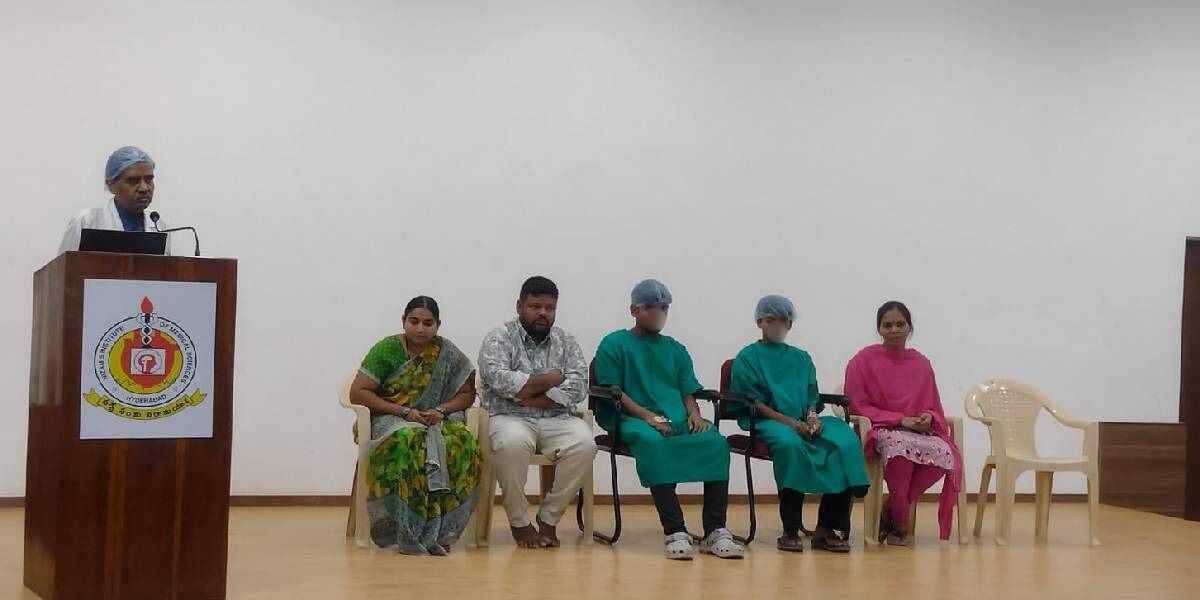The surgeries were performed completely free of charge with the help of Telangana’s Aarogyasri and the Chief Minister's Relief Fund (CMRF) programmes.
Published May 18, 2025 | 11:02 AM ⚊ Updated May 18, 2025 | 11:02 AM

Doctors at NIMS with the children who underwent the surgery. (Supplied)
Synopsis: Nizam’s Institute of Medical Sciences (NIMS) in Hyderabad’s cardiology team used 3D electroanatomic mapping to cure the heart ailments of two children. After the procedure, both boys are completely symptom-free. No more emergency visits, no more missed school days, and most importantly, no more fear.
For 15-year-old Raju*, a resident of the Khammam district of Telangana, growing up meant living with constant fear. Since early childhood, he had experienced sudden, racing heartbeats — often accompanied by chest discomfort, breathlessness, and profuse sweating.
These terrifying episodes would strike without warning, sometimes lasting several minutes, and over time, they robbed him of a normal childhood. Medicines offered little relief. Despite being under treatment for years, the episodes persisted, affecting his ability to attend school, play, or even rest properly.
In Hyderabad, 14-year-old Imran* faced a similar ordeal. Over just four months, he endured more than 25 attacks of intense heart palpitations. Each episode would send him to the emergency room, where doctors had to administer drugs through his veins to slow his heart. His school attendance dropped, and so did his confidence.
After seeking help at various private hospitals, both boys finally found lasting relief at Nizam’s Institute of Medical Sciences (NIMS) — a premier government-run super-speciality hospital in Hyderabad.
Both children were suffering from supraventricular arrhythmias — a group of heart rhythm disorders where the electrical system of the heart goes haywire, causing it to beat much faster than normal. These are not just occasional “racing heart” sensations; when recurrent and untreated, they can severely disrupt a child’s growth, learning, and quality of life.
Raju had an especially rare and complex case. His heart and other internal organs were found to be arranged in reverse — a condition called “situs inversus”, where the heart lies on the right side of the chest instead of the left. He was also diagnosed with Wolff-Parkinson-White (WPW) Syndrome, a congenital (birth-related) condition where an extra electrical pathway develops in the heart. This additional circuit can bypass the normal control system and lead to very fast, abnormal heart rhythms.
“This meant the usual approach to treating his heart would not work,” explained Dr Oruganti Sai Satish, a senior consultant cardiologist and electrophysiologist at NIMS. “His unusual anatomy made placing the catheters and interpreting the electrical signals extremely difficult.”
To overcome these challenges, the cardiology team used 3D electroanatomic mapping—a sophisticated computer-based system that builds a real-time, 3D model of the child’s heart. This allowed them to precisely locate and eliminate (ablate) the abnormal pathways using Radiofrequency Ablation (RFA), a minimally invasive procedure where heat is used to destroy the faulty tissue causing the arrhythmia.
In Imran’s case, the source of the arrhythmia was found deep inside the heart, near the mitral valve, on the left side. The electrical focus was acting like a short circuit, rapidly firing signals that caused repeated palpitations. “Finding and treating such a rare focus in a young patient is incredibly challenging,” said Dr Sai Satish. “But with 3D mapping and our experience in handling complex paediatric cases, we could safely ablate the area.”
After the procedure, both boys are completely symptom-free. No more emergency visits, no more missed school days, and most importantly, no more fear.
“This achievement is a testament to our institute’s commitment to clinical excellence and compassionate care,” said Dr Sai Satish in a statement.
“Radiofrequency Ablation is a curative treatment for many types of Supraventricular Tachycardia (SVT)—a category of arrhythmias where the electrical signals in the heart fire too rapidly. In skilled hands, it can give children their lives back,” he added.
The surgeries were performed completely free of charge with the help of Telangana’s Aarogyasri and the Chief Minister’s Relief Fund (CMRF) programmes.
The successful procedures were made possible by a dedicated team, including Dr Hemanth, Dr Sunita, Dr Ajeya, Dr Mounika, senior resident Dr Anurag, cath lab technicians Prameela and Rama Rao, and nursing officer Florence.
(*Names are changed. Edited by Muhammed Fazil.)
